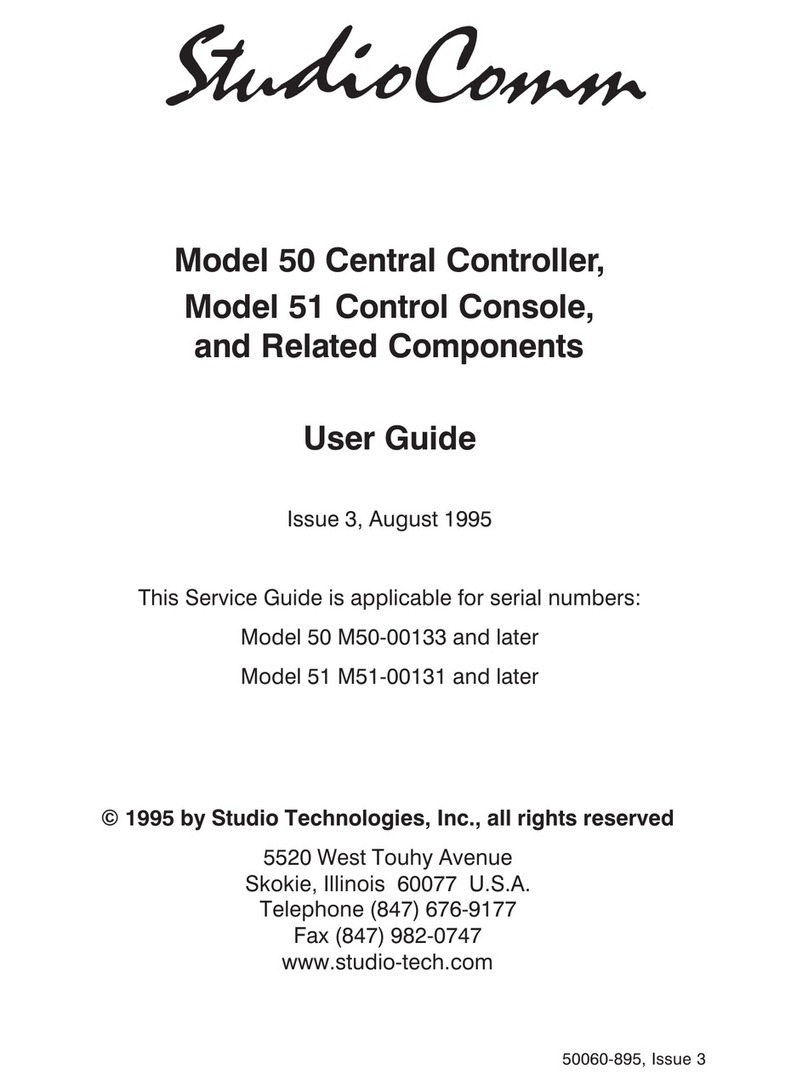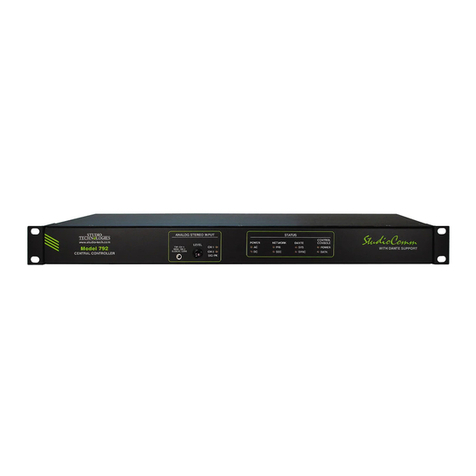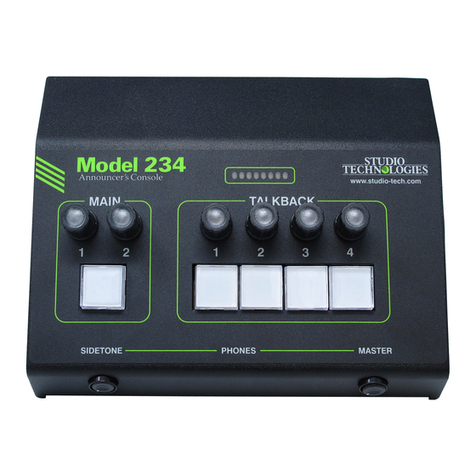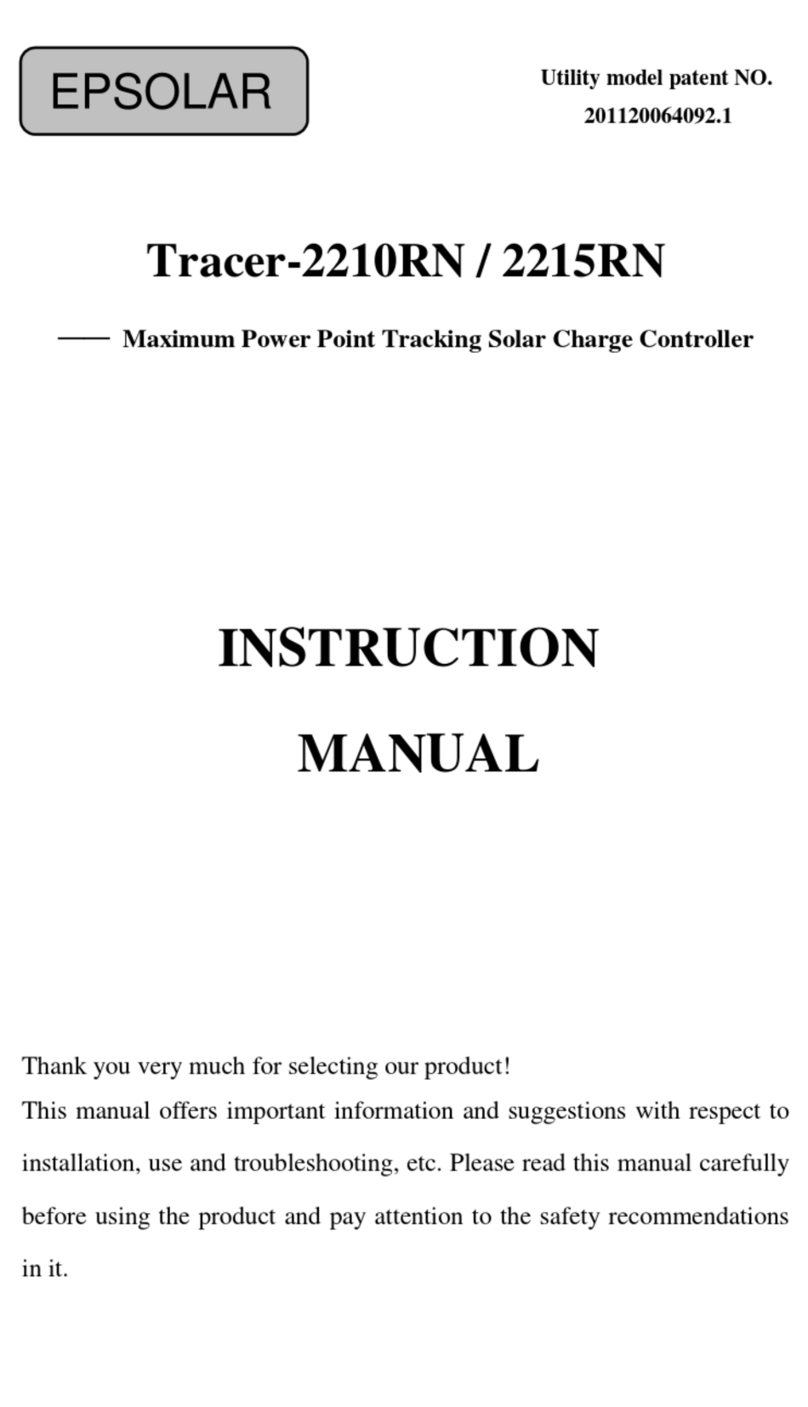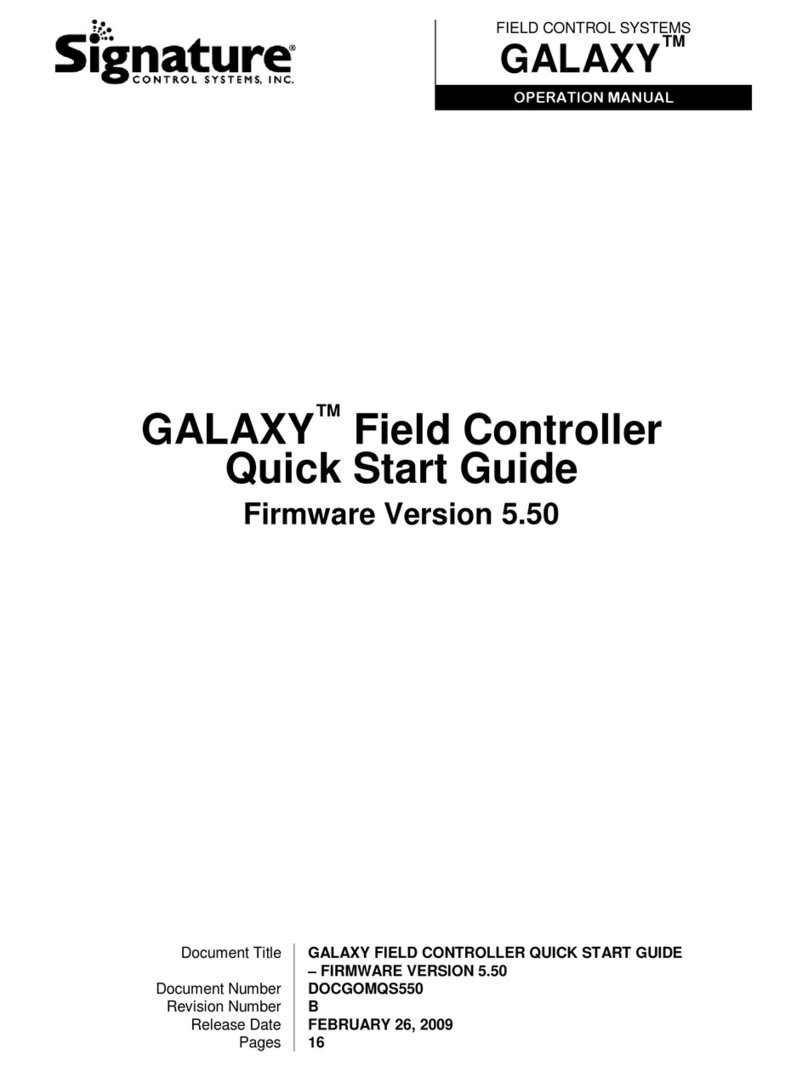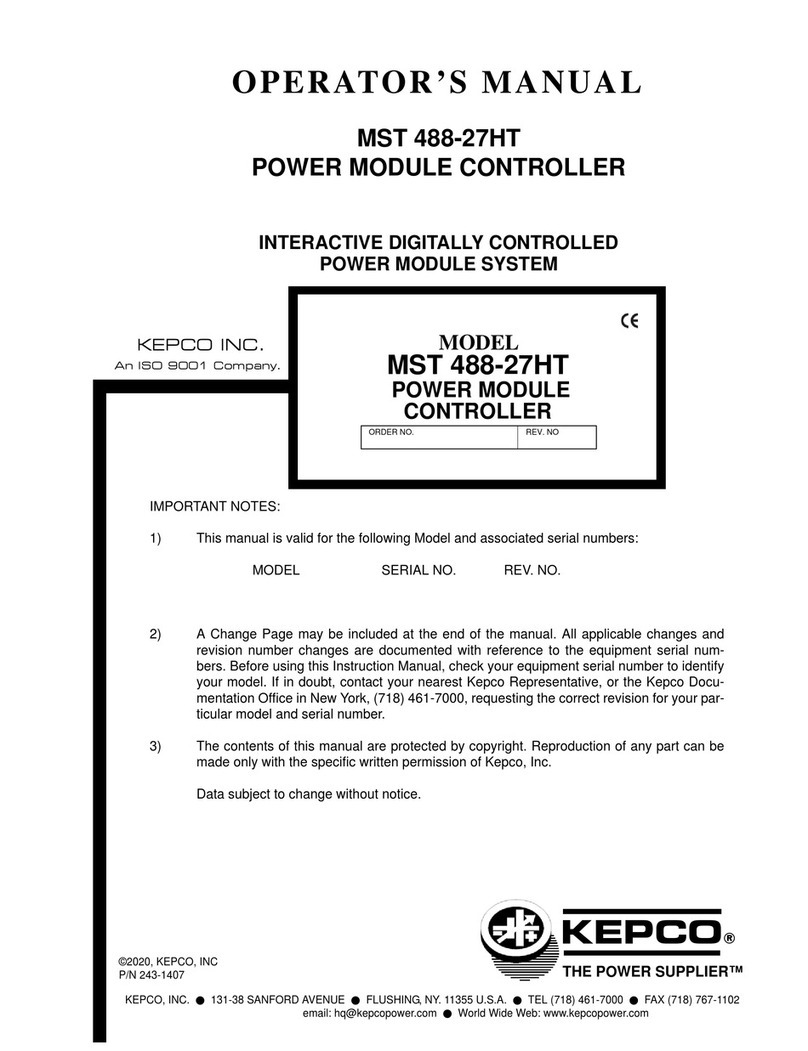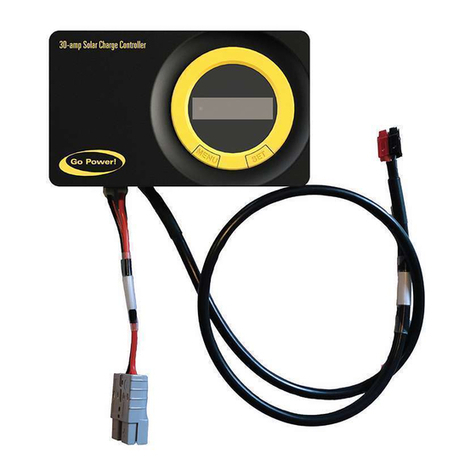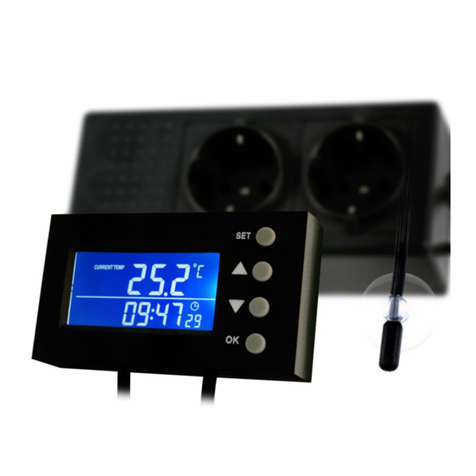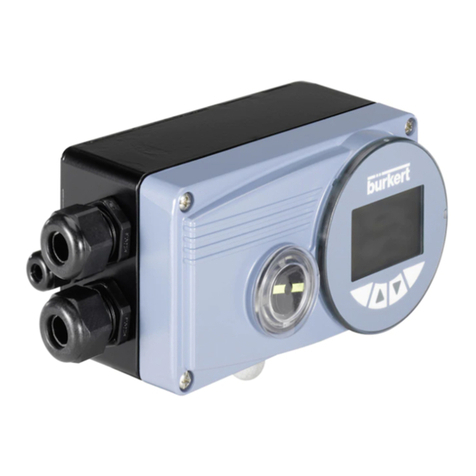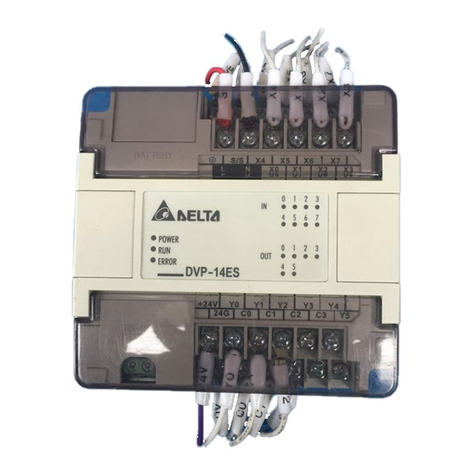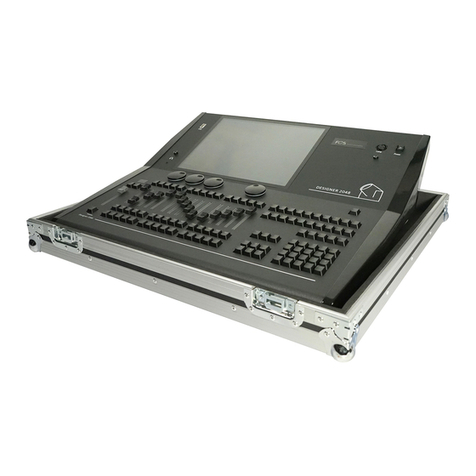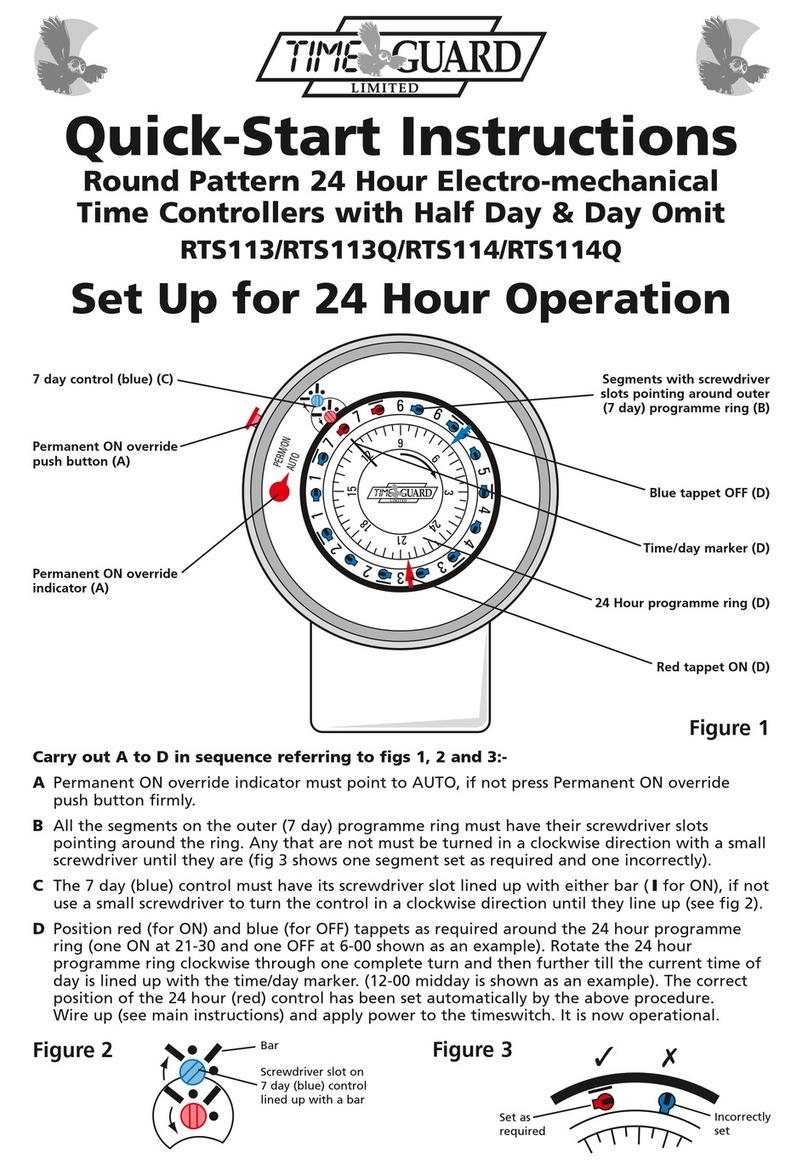Studio Technologies IFB Plus Series User manual

Copyright © 2015 by Studio Technologies, Inc., all rights reserved
www.studio-tech.com
50142-0315, Issue 2
User Guide
Issue 2, March 2015
This User Guide is applicable for serial numbers
M2A-03451 and later

This page intentionally left blank.

Model 2A User Guide Issue 2, March 2015
Studio Technologies, Inc. Page 3
Table of Contents
Revision History ........................................................... 4
Introduction ................................................................... 5
Installation .................................................................... 12
Operation ...................................................................... 24
Configuration ................................................................ 29
Technical Notes ............................................................ 31
Specifications ............................................................... 33
Appendix A–IFB Plus Series Mechanical Drawings ..... 37
Appendix B–IFB Plus Series Optional Accessories ...... 42

Issue 2, March 2015 Model 2A User Guide
Page 4 Studio Technologies, Inc.
Revision History
Issue 2, March 2015:
1. Documented revised telco interface new capabilities and connection details:
- Added the ability to connect both sources using jack 1.
- Also added switched output connections.
Issue 1, October 2013:
1. Initial release.

Model 2A User Guide Issue 2, March 2015
Studio Technologies, Inc. Page 5
Introduction
The IFB Plus Series Model 2A Central Con-
troller from Studio Technologies is a highly
integrated, 2-channel IFB (interruptible fold-
back) unit. It is the main component of the
IFB Plus Series which is expressly designed
to provide talent cueing for ENG, SNG, OB,
and mobile production facilities. It can also
find use in fixed installations that need a
compact but feature-rich stand-alone IFB
system. The performance and features of
the Model 2A, along with its companion
accessories, reflect the needs of contem-
porary applications. Only after extensive
polling of field production and engineering
personnel was the Model 2A’s feature group
established. We think you’ll find it to be a
great addition to your facility.
What This User Guide Covers
This guide is designed to assist you when
installing, configuring, and using the Model
2A Central Controller and related accesso-
ries. The following items will be covered in
this User Guide:
Model 2A Central Controller
The Model 2A Central Controller is an inte-
grated 2-channel IFB unit intended for ap-
plications where space is at a premium, yet
high performance is still required. The unit
contains everything required to implement
a full-featured system in a single space
(1U) of a 19-inch rack enclosure. The unit’s
resources include multiple program inputs,
integral telephone interfaces, monitor ampli-
fier output, internal interrupt microphone,
and support for additional talk locations.
The unit’s power input can range from 100
to 240 volts, 50/60 hertz. This “universal
input” ensures correct operation virtually
anywhere in the world.
Model 22 Access Station
The Model 22 Access Station is used by a
producer or director to access the Model
2A’s two IFB channels. It allows connec-
tion of a Studio Technologies’ Model 11A
Gooseneck Microphone or a line-level audio
source. The unit contains two lighted push-
button switches which display IFB interrupt
status. Up to four Model 22 units can be
connected to and powered by a Model 2A
Central Controller. The Model 25A 19-Inch
Rack Adapter allows a Model 22 Access
Station and Model 11A Gooseneck Micro-
phone to be mounted in a single space (1U)
of a standard 19-inch rack. The Model 28A
Panel Adapter allows a Model 22 and Model
11A Gooseneck Microphone to be installed
in an opening made in a table, equipment
console, etc. The Models 11A, 22, 25A, and
28A are purchased separately.
Figure 1. Model 2A Central Controller Front and Back Views

Issue 2, March 2015 Model 2A User Guide
Page 6 Studio Technologies, Inc.
Model 24 Access Station
The Model 24 Access Station allows broad-
cast personnel to access the four IFB chan-
nels associated with two Model 2A units.
The Model 24 contains five lighted pushbut-
ton switches, four of which are used to ac-
tivate and display the status of the four IFB
channels and one that provides an “all call”
function. The Studio Technologies’ Model
11A Gooseneck Microphone or a line-level
audio source can be connected. Up to four
Model 24 units can be connected and sup-
ported by two Model 2A units. The Model
27A 19-Inch Rack Adapter allows a Model
24 and a Model 11A Gooseneck Micro-
phone to be mounted in a single space of
a 19-inch rack enclosure. The Models 11A,
24, and 27A are purchased separately.
Model 32A and Model 33A Talent
Amplifiers
The Model 32A and Model 33A Talent
Amplifiers are self-contained “beltpack”
units that support connection of talent ear-
pieces or headsets. Purchased separately,
a total of up to six of these talent amplifiers
can be connected to, and powered by, a
single Model 2A Central Controller.
The Model 32A is intended for use by on-
air and production support personnel. It
connects to the Model 2A’s talent amplifier
output by way of a standard audio cable
that uses 3-pin XLR connectors. A “loop
through” 3-pin XLR connector is provided
on the Model 32A for easy interconnection
with additional talent amplifier units. The
Model 32A contains a power active LED
indicator light and 2-position source
switch, along with an output level control.
For user convenience, both ¼-inch and
3.5 mm monaural output jacks are provid-
ed. Either IFB channel 1 or 2 can be
selected, amplified, and sent to the output
jacks with the level adjusted as desired.
The Model 33A is similar to the Model 32A
but allows creation of a “mix” of IFB chan-
nels 1 and 2. Two level controls, along with
a source select switch, allows camera and
production personnel to hear cues from
either or both IFB channels. This allows
IFB signals intended for support person-
nel and on-air talent to be simultaneously
monitored. For user convenience, ¼-inch
and 3.5 mm monaural output jacks are
provided.
Model 2A Central Controller
Mounted in a single space of a 19-inch
rack, the Model 2A provides everything
required to implement a 2-channel IFB
system. Features include multiple program
inputs, telephone interfaces, voice-oper-
ated (VOX) interrupt, level meters, monitor
amplifier output, and an internal interrupt
microphone. In addition, up to four Model
22 or Model 24 Access Stations can be
connected to a Model 2A, allowing pro-
ducer or director positions to access the
IFB channels. In addition, up to six Model
32A or Model 33A Talent Amplifiers can be
connected to a Model 2A. These portable
“beltpack” units interconnect with a Model
2A using standard microphone cables.
Both DC power and two channels of audio
are supplied on just one 3-conductor ca-
ble, providing personnel with convenient,
reliable access to the two IFB channels.
The Model 2A packs numerous features
into a rugged yet lightweight single-rack-
space (1U) enclosure. Standard con-
nectors are used throughout, including
3-pin XLR, ¼-inch 2-conductor, 9-position
D-subminiature, and modular telephone
(RJ11) jacks. A source of 100-240 volts,

Model 2A User Guide Issue 2, March 2015
Studio Technologies, Inc. Page 7
50/60 hertz is connected via a detachable
mains cord and provides power for the
Model 2A.
IFB Channels
The Model 2A contains two independent
IFB channels. Each channel has individual
controls and indicators, including program
source select switches, program level con-
trol, 5-segment LED level meter, and LED
status indicators. The features of one of
two identical channels will be highlighted
in this paragraph. Six switches allow the
four program audio inputs and audio com-
ing from the two telephone interfaces to
be selected as program audio sources. A
rotary level control allows adjustment of
the program audio level relative to that of
the non-adjustable interrupt audio level. A
5-segment LED meter displays the level of
the composite IFB audio signal. (The com-
posite audio signal is the combination of
the selected program audio source(s) and
the interrupt audio source(s).) The level
meter facilitates the rapid setting of the
program level control, as well as providing
a general indication of the IFB channel’s
signal level.
Each channel’s composite IFB audio signal
(a mix of program and interrupt audio)
is sent to four places: a line-level output,
the talent amplifier output, telephone in-
terface 2, and the monitor output section.
Each line output provides an electronically
balanced, line-level signal that interfaces
with external equipment via a 3-pin XLR
connector. The talent amplifier output
provides IFB channel 1 and 2 audio, along
with 24 volts DC power on one 3-pin XLR
connector. Any combination of up to six
Model 32A or Model 33A units can be con-
nected to the talent amplifier output. For
application flexibility, the talent amplifier
output provides 200 ohm line impedances
on both of its output channels. This allows
direct connection of not just listen-only
devices, such as the Models 32A and 33A,
but party-line (PL) user beltpacks as well.
In this way popular PL beltpacks, from
suppliers such RTS® and Clear-Com®,
can be connected and used to create a
small PL intercom system that includes IFB
listen. A selector switch associated with
telephone interface 2 can be used by an
operator to send either IFB channel 1 or 2
out the connected phone line. The monitor
output section allows loudspeaker moni-
toring of audio from either IFB channel 1
or 2. (An optional external loudspeaker is
required.)
Program Inputs
The Model 2A contains four line-level
program inputs. Each can be individu-
ally assigned to the two IFB channels,
with the ability to assign multiple program
inputs to an IFB channel. Program signals
enter the unit via four 3-pin XLR connec-
tors located on the unit’s back panel. The
program inputs are electronically balanced
and feature low noise, low distortion, and
high common mode signal rejection. Each
program input has a trim potentiometer as-
sociated with it. The trim pots, accessible
from the back panel, allow source signals
with a nominal level of –10 to +8 dBu to be
correctly utilized.
Program audio is muted whenever inter-
rupt activity is taking place. Solid-state
circuitry is used to provide noise-free audio
switching with essentially no “clicks” or
“pops” added. If desired, a program “dim”
rather than a full mute can be implemented
by adding two resistors to the Model 2A’s
circuit board.

Issue 2, March 2015 Model 2A User Guide
Page 8 Studio Technologies, Inc.
Compressor Circuits
The two IFB channels contain studio-quality
compressor circuitry to control the dynamic
range of the interrupt audio. These play an
important role in how the Model 2A main-
tains high audio quality, specifically evening
out level variations presented by the talk
signals associated with various IFB users.
The compressors make talent cues more
intelligible and prevent abnormally high
signal levels from reaching user’s ears. The
resulting audio quality is very, very good.
Telephone Interfaces
The Model 2A contains two telephone
interfaces. Both interfaces can be used
to bring audio into the Model 2A from the
outside world. These two audio signals can
be independently assigned as program
sources for IFB channels 1 and 2, as well
as being used as an audio source for the
voice operated (VOX) interrupt function.
Each telephone interface has a receive-lev-
el trim potentiometer that is accessible via
a small hole in the front panel. The large
level variations that can be presented by a
telephone line can make “on the fly” level
trimming a useful feature. In addition to re-
ceiving audio, telephone interface 2 can be
used to originate an IFB “feed” (IFB output).
A switch selects if audio will be received
from the outside world, or if audio from IFB
channel 1 or 2 will be sent out the interface.
The telephone interfaces contain a unique
feature which allows two very different
types of telephone “lines” to be correctly
interfaced. Each interface can be indepen-
dently set to operate in either a telephone
line mode or a standard audio mode. A
telephone line has the profile of being a 2-
wire, DC-biased (normally –48 volts) circuit
provided by a local telephone company,
long-distance carrier, or private telephone
system. A standard audio signal could be
provided by, for example, a “dry” (no DC
voltage provided) fax adapter associated
with a cellular telephone.
When an interface is set to the telephone
line mode and a telephone line with DC
voltage is connected, full monitoring and
control is implemented. Each interface con-
tains a switch that allows the telephone line
to be answered (taken “off hook”) or hung
up (placed “on hook”). DC loop current is
monitored when the interface is active (off
hook). If a telco-provided disconnect signal
(a momentary break in loop current) is de-
tected the interface will automatically return
to its idle (on-hook) state. Telephone inter-
face 1 contains an LED status indicator that
lights whenever loop current is detected.
Telephone interface 2 has a status LED that
“flashes” when a ringing signal is detected
and lights continuously when loop current
is detected. Interface 2 also implements an
auto answer function which can automati-
cally take the telephone line to the answer
(off-hook) state when a ringing signal is
detected.
In many cases a “telephone line” in a mo-
bile broadcast application is actually pro-
vided by a cellular telephone. This cellular
telephone may provide a “dry” (no DC loop
current) audio output signal. The standard
audio mode was designed expressly to
interface with this “cell phone” arrange-
ment. In this mode, the interface’s loop
current-specific features are disabled, and
the interface appears electrically as a trans-
former-coupled balanced audio interface.
When an interface has been set for the
standard audio mode its front-panel line
status switch is inactive as is its loop status
LED. Also inactive in the standard audio

Model 2A User Guide Issue 2, March 2015
Studio Technologies, Inc. Page 9
switches, allowing the internal microphone
to interrupt IFB channel 1, channel 2, or
both channels 1 and 2.
Monitor Output
The Model 2A contains a simple but excel-
lent monitor output section. At the core is
a 4 watt high-performance audio amplifier
designed to drive an 8 ohm (or greater)
loudspeaker. (The speaker is optional
and is provided as part of an installation.)
Associated with the monitor output are a
3-position source select switch and a level
control. The switch selects whether IFB
channel 1 or IFB channel 2 will be moni-
tored, as well as having an off position. A
click-free circuit mutes the monitor output
whenever the internal microphone or a
Model 22 or Model 24 Access Station is
interrupting either IFB channel.
Model 22 Access Station
The Model 22 Access Station and related
accessories (all purchased separately)
provides the capability for adding up to
four additional interrupt locations. Model
22 units are intended to be installed at
positions convenient to producers, direc-
tors, or other personnel who need to “cue”
talent and related personnel. The unit
consists of a metal chassis containing two
lighted pushbutton switches, unbalanced
microphone and balanced line inputs, and
status and control circuitry.
mode is telephone interface 2’s auto an-
swer function. An LED associated with
each telephone interface displays when
the standard audio mode is selected.
Voice Operated (VOX) Interrupt
The Model 2A contains circuitry to allow
an audio signal to serve as both an inter-
rupt audio source and a control signal.
This eliminates the need for a separate
push-to-talk button or contact closure. The
VOX feature allows an audio signal from
a remote source, such as a 2-way radio
or telephone line, to serve as the interrupt
source. The VOX function was optimized
for detecting audio signals in the voice
band. As voice detection is not a trivial
task, great care was taken when designing
the circuitry to support this function.
Three signals can serve as the audio
source for the VOX interrupt function:
receive audio from telephone interface 1,
receive audio from telephone interface 2,
or the auxiliary audio input. The auxiliary
audio input is a separate line-level audio
input that is only associated with the VOX
interrupt function. A 3-position switch se-
lects which source will be used. A second
3-position switch is used to select which
IFB channel is to respond to the VOX inter-
rupt function. The VOX interrupt function
can be assigned to only one IFB channel
at a time or it can be disabled. Each IFB
channel contains an LED indicator light
to display when a VOX (voice-activated)
interrupt is taking place.
Internal Interrupt Microphone
Contained behind the Model 2A’s front
panel is an internal interrupt microphone.
Associated with the microphone are two Figure 2. Model 22 Access Station Front View

Issue 2, March 2015 Model 2A User Guide
Page 10 Studio Technologies, Inc.
The two high-quality backlit pushbutton
switches provide access to the Model 2A’s
two IFB channels. The lights in the switch-
es display when an interrupt is taking place
on its respective channel; lighting brightly
when IFB is active and dim when IFB is
idle. An input select switch allows con-
nection of a Model 11A Gooseneck Micro-
phone or external line-level signal source.
The electronically balanced line-level input
allows interfacing with other communica-
tions equipment, such as “hot mic” signals
from an intercom user station.
The Model 22 can be configured to mute
the Model 2A’s monitor amplifier output.
This function will prevent acoustic feedback
from occurring when a Model 22 is located
close to the Model 2A’s monitor speaker.
Model 22 Access Stations are linked to the
associated Model 2A Central Controller via
9-pin D-subminiature female connectors.
Each access station contains two connec-
tors, allowing a simple daisy-chain installa-
tion. The nine leads carry all signals; audio,
control, status lamp (tally), and power. The
Model 2A provides all power required by
the access stations. The Model 25A 19-
Inch Rack Adapter is available to mount a
Model 22 and a Model 11A Gooseneck Mi-
crophone in one space (1U) of a standard
19-inch rack. The Model 28A Panel Adapter
allows a Model 22 and a Model 11A Goose-
neck Microphone to be mounted in a panel
opening. Refer to Appendix B for details on
these optional accessories.
Model 24 Access Station
The Model 24 is similar to the Model 22
with the exception that it works with two
Model 2A units. In this way production
personnel can access all four of the IFB
channels associated with the two Model
2A units. Up to four Model 24s can be con-
nected to each Model 2A. A Model 24 unit
consists of a metal chassis that holds five
lighted pushbutton switches, audio and
control circuitry, and microphone and line
input connectors.
Figure 3. Model 22 Access Station shown mounted in optional Model 25A 19-Inch Rack Adapter with
optional Model 11A Gooseneck Microphone
Each of the four IFB channel pushbutton
switches display when an interrupt is taking
place on its respective channel. A fifth but-
ton is specified as “all call” and lights when
pressed. The Model 24 supports connec-
tion of an optional Model 11A Gooseneck
Microphone or a line-level signal. The latter
is transformer-balanced, allowing compat-
ibility with virtually any line-level source. A
switch is used to select the interrupt audio
Figure 4. Model 24 Access Station Front View

Model 2A User Guide Issue 2, March 2015
Studio Technologies, Inc. Page 11
source. A second switch allows the Model
24 to mute the monitor output on each of the
Model 2A units whenever an IFB channel is
activated.
Model 24 Access Stations connect to the
associated Model 2A units using two 9-pin
D-subminiature connectors. The nine con-
ductors that link each Model 2A with the
Model 24 support all the audio, signaling,
and power requirements. No external power
source is required. The optional Model 27A
allows a Model 24, along with a Model 11A
Gooseneck Microphone, to be mounted in
one space (1U) of a standard 19-inch rack
enclosure. Refer to Appendix B for details
on these optional accessories.
Model 32A and Model 33A
Talent Amplifiers
Model 32A and Model 33A Talent Amplifiers,
purchased separately, are self-contained
“beltpack” units that drive talent earpieces
or headsets. An audio cable with 3-pin XLR
connectors on its ends links the talent ampli-
fiers with a Model 2A. Each Model 32A and
Model 33A contains both a male and female
3-pin XLR connector, allowing simple “loop
through” connection of multiple units. Up to
six of the talent amplifiers can be connected
to, and powered by, a single Model 2A Cen-
tral Controller. On each talent amplifier the
audio output signal is provided on both a
¼-inch 2-conductor phone jack and a
3.5 mm output jack. An LED on each unit
lights whenever power is present, provid-
ing setup assistance and user confidence.
Identical in size, each is housed in a light-
weight, yet rugged, aluminum housing.
A belt clip allows it to be attached to belts,
clipboards, scabbards, pizza boxes, pro-
duction assistants, etc. An optional mount-
ing adapter kit (Order Code: TAB-01)
is available, allowing a Model 32A or
Model 33A to be installed in a permanent
location.
The Model 32A is typically used by on-air
personnel, and contains a source selection
switch, along with an output level control.
Either IFB channel 1 or IFB channel 2 can
be sent to the talent, along with the desired
audio “volume.”
Figure 5. Model 24 Access Station shown mounted in optional Model 27A 19-Inch Rack Adapter with
optional Model 11A Gooseneck Microphone
Figure 6. Model 32A Talent Amplifier (top) and
Model 33A Talent Amplifier (bottom)

Issue 2, March 2015 Model 2A User Guide
Page 12 Studio Technologies, Inc.
The Model 33A is unique in that a “mix” of
IFB channels 1 and 2 can be created. Two
level controls, along with a source selection
switch, allows camera and production per-
sonnel to hear IFB cues from either or both
channels. This allows IFB signals intended
for both production personnel and on-air
talent to be simultaneously monitored.
Installation
In this section you will be installing a Model
2A Central Controller in a standard 19-inch
equipment rack. In conjunction with the
Model 2A, up to four Model 22 or Model 24
Access Stations can be installed. In addi-
tion, wiring can be installed for up to a total
of six associated Model 32A and Model 33A
Talent Amplifiers.
The Model 2A will arrive from the fac-
tory configured for compatibility with most
applications. However, there are several
reasons why you may need to access the
“guts” of the unit:
• From the factory, telephone interface 2
is typically configured to automatically
answer the telephone line after detect-
ing one ring. Switches can be config-
ured to allow auto-answer to take place
after one ring, two rings, four rings, or
be disabled (never auto answer).
• From the factory, the Model 2A is set to
mute program audio when an interrupt
takes place. If desired, a program “dim”
function, rather than mute function, can
be implemented.
Refer to the Configuration section of this
guide for details on revising these condi-
tions and the safety precautions that must
be observed.
In addition to these situations, you may
want to take a look inside and familiarize
yourself with the unit on the rare occasion
that it may need service. (The people here
in the marketing department taught us
never to say a unit may need to be fixed—
service is much nicer!) We are proud of
how the “guts” of the Model 2A look and
how it is constructed so we encourage you
to take a “peek”!
On a more serious side, removing the
Model 2A’s cover with the AC mains cord
connected exposes you to hazardous
voltages.
Warning: Never remove the cover
without disconnecting mains power. We
make the assumption that anyone gain-
ing access to the inside of our products
meets the requirements for “qualified
and competent service personnel”—
including having knowledge of safety
precautions.
Locating the Unit
Physical access and mechanical noise
are the primary factors when choosing a
Model 2A mounting location. You don’t
want a cooling fan blowing directly onto
the internal microphone, nor do you want
the microphone at the level of your belt. It
is also a good idea to keep the Model 2A
physically separated from other electronic
devices that produce strong electrical
fields. As a device that contains high gain
audio stages, hum and noise pickup is
possible through the chassis and associ-
ated cabling. Locating the unit away from
devices such as power amplifiers, large
power transformers, and lighting controls
will help avoid pickup of unwanted signals.

Model 2A User Guide Issue 2, March 2015
Studio Technologies, Inc. Page 13
Typically interference from outside signals
will not be an issue. But precautions were
taken in the Model 2A’s circuit designs to
limit bandwidth, minimizing the chance that
EMI and RF pickup problems will occur.
Mounting
The Model 2A is intended for mounting in a
standard 19-inch rack, requiring one 1.75-
inch rack space (1U). The unit is secured
to the rack’s front mounting rails using two
mounting screws per side.
Program Inputs
The Model 2A allows four line-level pro-
gram audio sources to be connected. The
input circuitry is designed for compatibility
with signals that have a nominal level in
the range of –10 to +8 dBu, although it’s
expected that most connected signals will
have a nominal level of +4 dBu. A level ad-
justment trim potentiometer (“trim pot”) is
associated with each program input. These
trim pots are not intended for precise
calibration, but strictly to allow the program
input signals to be adjusted to the same
relative level. A little attention when setting
the trim pots will give optimal operational
performance. Correctly setting the trim
pots will allow an operator, using the front-
panel program select switches, to rapidly
change the selected program sources
while not presenting large changes in level
to users listening to the IFB outputs. It is
intended that the trim pots will be adjusted
only upon initial installation or during main-
tenance; they are not considered an op-
erator function. Refer to the Configuration
section of this guide for details on setting
the trim pots.
Connections to the program audio inputs
are made by way of the four 3-pin female
XLR connectors that are located on the
Model 2A’s back panel. They are labeled
A, B, C, and D, corresponding to label-
ing on the program selection switches on
the front panel. The input circuitry is direct
coupled, electronically balanced with an
input impedance of 24 k ohms. Prepare
cable-mounted 3-pin male XLR connectors
such that pin 2 is positive (+ or hot), pin 3
is negative (– or cold), and pin 1 is shield.
With unbalanced signals connect pin 2 to
positive and pins 1 and 3 to shield.
Auxiliary Audio Input
The Model 2A allows a line-level audio
source to be connected and used by the
voice operated (VOX) interrupt function.
The input circuitry is designed for com-
patibility with signals that have a nominal
level over a range of –10 to +8 dBu. A level
adjustment trim pot is associated with the
auxiliary input. The pot is not intended for
precise calibration, but strictly to allow the
AUX input level to be adjusted for correct
VOX operation. The trim pot is intended to
be adjusted only upon initial installation or
during maintenance and is not considered
an operator function. Refer to the Configu-
ration section of this guide for details on
adjusting the trim pot.
A connection to the auxiliary audio input
is made via a 3-pin female XLR connector
on the Model 2A’s back panel. It is labeled
AUX. The input circuitry is direct coupled,
electronically balanced with an input im-
pedance of 24 k ohms. Prepare the cable-
mounted 3-pin male XLR connector so that
pin 2 is positive (+ or hot), pin 3 is negative
(– or cold), and pin 1 is shield. With an un-
balanced signal connect pin 2 to positive,
and pins 1 and 3 to shield.

Issue 2, March 2015 Model 2A User Guide
Page 14 Studio Technologies, Inc.
The VOX interrupt function is quite spe-
cialized and may not be used regularly in
all applications. For maximum flexibility, it
may be best to terminate the auxiliary au-
dio input to a patch point in an audio patch
bay. In this way, a variety of audio sources
can quickly be “patched in” as the VOX
interrupt input source. The VOX feature
may remain unused for months or years,
but when you need it there’s no substitute!
The Model 2A’s VOX interrupt function per-
forms very well, possibly better than you
may think. Try it out and you may soon find
more applications than you expected.
Talent Amplifier Output
The talent amplifier output is designed to
supply power and two audio signals for
up to six Model 32A or Model 33A Talent
Amplifiers. Both audio channels maintain
200 ohm impedances which also allows
connection of party-line (PL) intercom
beltpacks. The talent amplifier output is
connected via a 3-pin male XLR connec-
tor located on the back panel. Pin 1 is
common, pin 2 is 24 volts DC modulated
with IFB channel 1 audio, and pin 3 is IFB
channel 2 audio. For convenience, it is
expected that the talent amplifier output
will be wired to a main input/output (I/O)
panel, along with microphone, camera,
and other related signals. This will allow
easy talent amplifier interconnection using
standard portable microphone or general
audio cables. As a minimum, including
one 3-pin male XLR connector on the I/O
panel for connecting to talent amplifiers
is necessary. But for good operator flex-
ibility it would be better to include two or
three connectors that are “multed” from
the Model 2A’s talent amplifier output. Also
note that each Model 32A and Model 33A
Talent Amplifier has both a female and a
male 3-pin XLR connector. This allows tal-
ent amplifier interconnecting cables to be
“looped” through one talent amplifier and
then on to another. This will simplify and, in
most cases, reduce the amount of cabling
required to connect multiple talent ampli-
fiers to a Model 2A.
Line Outputs
Associated with each of the two IFB chan-
nels is a level output with a nominal signal
level of +4 dBu. The line outputs are elec-
tronically balanced, capacitor-coupled and
designed to drive balanced loads with a
minimum impedance of 2 k (2000) ohms.
Each line output exits the Model 2A via a
3-pin male XLR connector. Prepare the
cable-mounted 3-pin female XLR con-
nectors so that pin 2 is positive (+ or hot),
pin 3 is negative (– or cold), and pin 1 is
shield. To connect to an unbalanced load
connect pin 2 to positive (+ or hot) and pin
3 to shield; do not short (connect) pin 3 to
pin 1.
Some installations may use the line out-
puts to drive wireless IFB transmitters. In
other installations they may be used for
special applications such as feeding a
satellite uplink. For maximum flexibility it
is recommended that the line outputs be
wired via audio patch points, even if the
initial installation doesn’t require it.
The Model 2A’s audio quality and flexibility
make it a useful tool for non-IFB applica-
tions. The Model 2A’s sonic quality is as
good as many audio consoles, storage
devices, etc. This makes using an IFB
channel as a 4-input/1-output audio source
selector for an uplink application complete-
ly valid. Let the Model 2A become a useful
part of your facility’s “bag of tricks!”

Model 2A User Guide Issue 2, March 2015
Studio Technologies, Inc. Page 15
Connecting to the Telephone
Interfaces
Caution: Never install telephone wiring
during a lightning storm. Never install
telephone jacks in wet locations unless
the jack is specifically designed for wet
locations. Never touch non-insulated
telephone wires or terminals unless the
telephone line has been disconnected
at the network interface. Use caution
when installing or modifying telephone
lines.
Overview
The Model 2A contains two telephone
interfaces which can be individually
configured to allow connection to a tele-
phone line or to a standard audio signal.
A telephone line is designated as such if
it has a DC voltage (typically –48) associ-
ated with it. This type of telephone line is
sometimes referred to as being a “wet”
line. A standard audio signal is one that is
isolated from any source of DC voltage.
Some fax adapters associated with cellular
telephones provide this type of “telephone”
line. A standard audio signal is sometimes
referred to as a “dry” signal. While this
sounds confusing, contemporary applica-
tions sometimes refer to both types of
signals as “telco.” To a large production ve-
hicle that pulls up to do a 2-week golf tour-
nament, a telco line often is one provided
by the local telephone company terminated
on an RJ11 jack. To a mobile news gath-
ering (ENG) vehicle, a telco signal might
come from an adapter associated with a
cellular telephone which in many cases is
simply a standard audio signal.
Some of the important features of the Model
2A’s telephone interfaces include:
Telephone Interface 1
• Telephone line or standard audio mode
select switch on back panel
• Used to receive audio only
• Receive audio can be used as program
and VOX source
• Front-panel ±8 dB receive level trim pot
• Front-panel switch allows manual an-
swer and hang-up (telephone line mode)
• Auto disconnect upon telco-provided
break in loop current (telephone line
mode)
• Front-panel operating mode and loop
current status LEDs
• 6-position modular jack allows input and
output connections for telco interface 1
and an input connection for telco inter-
face 2
Telephone Interface 2
• Telephone line or standard audio mode
select switch on back panel
• Used to receive or send audio
• Receive audio can be used as program
and VOX source
• Front-panel ±8 dB receive level trim pot
• Sends audio from either IFB channel
• Automatic answer of “ringing” telephone
line (telephone line mode)
• Auto disconnect upon telco-provided
break in loop current (telephone line
mode)

Issue 2, March 2015 Model 2A User Guide
Page 16 Studio Technologies, Inc.
• Front-panel switch allows manual
answer and hang-up (telephone line
mode)
• Front-panel operating mode and ring
activity/loop current status LEDs
• 6-position modular jack allows input and
output connections for telco interface 2
Selecting the Operating Mode
The telephone interface mode switches,
located on the back panel, are used to
select the desired operating mode—
either telephone line or standard audio. If
the telephone line mode is selected, the
Model 2A’s telephone interface connections
should, in most cases, terminate on an
I/O panel of some type. Typically this panel
might include modules jacks (“RJ11”)
and “5-way” screw binding posts. This
will allow rapid connection with telephone-
company-provided lines that arrive in a vari-
ety of wiring schemes. Because of the likely
presence of high-voltage ringing signals, it
is strongly advised to not route telephone
lines through an audio patch bay.
If the standard audio mode is selected
direct connection of an audio source is
acceptable. But connecting them via audio
patch points will provide better flexibility.
In the standard audio mode each interface
acts like a transformer-coupled balanced
audio input. Interface 1 has an input imped-
ance of 2200 ohms. Interface 2 has an in-
put impedance of 2200 ohms in the receive
mode and 700 ohms in the send mode. In
the standard audio mode, the interfaces are
compatible with balanced or unbalanced
signals. No shield connection is associ-
ated with the telephone interfaces. If pos-
sible, audio signals should be connected
to the Model 2A’s telephone interfaces, via
a modular plug and cable, using shielded
cable, with the shield wire connected to the
appropriate point at the end opposite of the
Model 2A. The shield wire should remain
unterminated at the Model 2A’s end.
Connecting to the Telephone Jacks
Modular telephone line cords are used to
connect input and output signals with the
Model 2A’s two 6-position modular jacks.
(These jacks are typically called RJ11
jacks but that’s not really technically cor-
rect. Starting in the early 1960s an RJ11
was a telephone-company-provided tele-
phone line that was terminated on pins 3
and 4 of a 6-position keyed modular jack.)
The original Model 2 and Model 2A units
just connected telco signals using pins 3
and 4. But Model 2A units with serial num-
bers 03451 and later take advantage of
the previously-unused pins and circuitry
capability. As such, the Model 2A uses
more than just pins 3 and 4 to bring signals
in to and out of the two telephone inter-
faces. This flexibility is provided to ease
installation and add enhanced functionality.
The jack on the Model 2A’s back panel that
is labeled 1 can be are used to connect
three different signals: telephone interface
1 input, telephone interface 2 input, and
telephone interface 2 switched output.
Pins 3 and 4 bring the tip and ring leads
into telephone interface 1. Pins 5 and 2
can be used to bring the tip and ring leads
into telephone interface 2. (They are elec-
trically in parallel with pins 3 and 4 of the
jack labeled 2.) This is provided so that
a single cable can carry the connections
for two lines, bringing signals into both
interface 1 and interface 2. Pins 6 and 1
can be connected to a telephone device
which would receive the signal connected
to the interface 1 input whenever the Mod-
el 2A’s interface 1 circuitry is not active

Model 2A User Guide Issue 2, March 2015
Studio Technologies, Inc. Page 17
(interface 1 is “on-hook”). The connections
on these pins pass through the Model 2A’s
on/off control circuitry (the “off hook” relay)
from pins 3 and 4. Refer to Figure 7 for con-
nection details.
The jack on the Model 2A’s back panel that
is labeled 2 can be used to connect two
different signals: telephone interface 2 input
and telephone interface 2 switched output.
Pins 3 and 4 bring the tip and ring leads
into telephone interface 2. (They are electri-
cally in parallel with pins 5 and 2 on the
jack for interface 1.) Pins 6 and 1 can be
connected to a telephone device which
would receive the signal connected to the
interface 2 input whenever the Model 2A’s
interface 2 circuitry is not active (interface
2 is “on-hook”). The connections on these
pins pass through the Model 2A’s on/off
control circuitry (“off hook” relay) from pins
3 and 4. Pins 2 and 5 are not used and
should be left un-terminated. Refer to
Figure 7 for details.
Signal Levels and Receive Trim Pots
The telephone interfaces were designed
to receive and, in the case of interface 2,
send audio signals at a nominal level that is
correct for telephone circuits. This nominal
level is far lower than the typical +4 dBu
professional audio standard. The receive
signal level is expected to be approximately
–15 dBu while the transmit level is ap-
proximately –6 dBu. A trim pot, accessible
on the front panel, is associated with each
telephone interface. This allows the receive
level to be adjusted over a ±8 dB range.
Special precautions may need to be taken
when an interface is set for standard audio
mode and +4 dBu signals are going to be
connected. Including an audio attenuator or
“pad” with a value of somewhere between
10 and 20 dB in series with the source sig-
nal will optimize the receive audio level. In
addition, using a line amplifier or other gain
stage to achieve a higher send level from
telephone interface 2 may be helpful.
Figure 7. Telco jack connection details

Issue 2, March 2015 Model 2A User Guide
Page 18 Studio Technologies, Inc.
Model 22 Access Stations
The Model 2A allows the connection of up
to four Model 22 Access Stations. The Mod-
el 22 provides an unbalanced microphone
input, a balanced line-level input, two light-
ed pushbutton switches, and related circuit-
ry. Power is provided by the Model 2A so
an external power source is not required. A
cable with 9-pin D-subminiature male (DE-
9M) connectors on each end links a Model
2A Central Controller with the rst Model 22
Access Station. Identical cables are used to
interconnect up to three additional Model 22
units in a daisy-chain fashion. A 5-position
screw terminal strip, located on the rear of
the Model 22, allows connection of either a
Studio Technologies’ Model 11A Gooseneck
Microphone or a line-level audio signal.
Mounting Methods
There are three mounting methods ap-
propriate for the Model 22: the Model 25A
19-Inch Rack Adapter, the Model 28A Panel
Adapter, or a custom implementation. The
Model 25A 19-Inch Rack Adapter allows a
Model 22 and a Model 11A Gooseneck
Microphone to be mounted in a single
space (1U) of a standard 19-inch rack.
Refer to Appendix A for details on how the
Model 22 is physically positioned in the
Model 25A 19-inch Rack Adapter. Plenty
of room remains on the right side of the
rack adapter plate, allowing the addition of
custom switches, lights, or jacks as your
installation may require. (Of course any
modications will have to be implemented
by installation personnel.)
The Model 28A Panel Adapter allows the
installation of a Model 22 and a Model 11A
Gooseneck Microphone in a “cut out” made
in a desk, console, or other enclosure.
Refer to Appendix A for a mechanical
drawing of the panel adapter and the re-
quired dimensions of the mounting opening.
A custom Model 22 installation is any ap-
plication where installation personnel devise
an alternative mounting method. Refer to
Appendix A for a mechanical drawing show-
ing detailed dimensions of the Model 22.
Interconnect Wiring
Contained on both the Model 2A and the
Model 22 are 9-pin D-subminiature female
(DE-9F) connectors. A “straight through”
cabling scheme links the units together, with
pin 1 connected to pin 1, pin 2 to pin 2, etc.
Shielded cable is required as the two audio
buses linking the Model 22 units to a Model
2A are unbalanced. The shield should be
connected to pin 1 on the 9-pin plugs. For
reference, the following chart displays the
signals associated with the access station
connector:
Pin # Function Direction
1 Common/Shield Input/Output
2 Interrupt Audio, Ch 1 Input
3 Interrupt Audio, Ch 2 Input
4 18 volts DC Output
5 Interrupt Control, Ch 1 Input
6 Interrupt Control, Ch 2 Input
7 Lamp Voltage, Ch 1 Output
8 Lamp Voltage, Ch 2 Output
9 Monitor Output Mute Control Input
Note:
Connector type on Model 2A is a 9-pin D-subminia-
ture female (DE-9F). Installer must provide a 9-pin
D-subminiature male (DE-9M). Connector uses
4-40 threaded inserts for locking with mating plug.
Figure 8. Model 22 Access Station Connections

Model 2A User Guide Issue 2, March 2015
Studio Technologies, Inc. Page 19
For ease of installation, each Model 22
contains two 9-pin D-subminiature female
connectors (DE-9F). The pins on both
connectors are wired in parallel (“multed”).
This allows signals to be easily “looped
through” on their way to the next Model 22.
For short cable runs, standard 9-pin video
monitor extension cables, commonly used
with older-style personal computers, are
an inexpensive way to link a Model 22 with
a Model 2A. Ensure that any cable assem-
blies you purchase use shielded cable,
with the shield connected at pin 1 of both
plugs.
For optimal audio performance a maximum
total cable length of 500 feet can used to
link Model 22 units to the Model 2A. But
minimizing the cable length will reduce the
total exposure that the unbalanced audio
buses will have to noise pickup, etc. Cable
runs longer than 500 feet are possible but
should be carefully checked for correct
operation.
It’s come to the factory’s attention that
some installers have been eectively using
standard Ethernet cables to link Model 22
units with Model 2A units. They start by us-
ing adapters that convert 9-pin D-submin-
iature connectors to RJ45 (8-pin module)
jacks. Then they select or create standard
Ethernet cables to support the cable “run.”
There is one downside in that these cables
will only support eight signals and not the
complete nine used by the Model 22 and
Model 2A. Physical pins 1-8 will be con-
nected but not pin 9. This will implement
all functions except the Model 22’s ability
to mute the Model 2A’s monitor speaker
output. This is because pin 9 of the D-sub-
miniature connector enabled this function.
If the installation doesn’t require muting of
the monitor output speaker in response to
Model 22 IFB activity then this installation
may prove worthwhile.
Talk Audio Source
A source of talk audio must be connected
to the Model 22. A gooseneck microphone,
available as an option from Studio Tech-
nologies, will often be used with a Model
22. Alternately, a source of line-level au-
dio can be connected. A 5-position screw
terminal strip is used to connect signals to
the mic and line inputs. The mic input is
congured only for use with unbalanced
electret microphones. The + terminal on
the mic input provides current limited 5
volts DC to power the electret microphone.
The – terminal is connected to the micro-
phone’s low signal lead. The connection
marked SHLD is intended for the shield
wire of the microphone cable; it doesn’t
carry signal.
The Studio Technologies’ Model 11A
Gooseneck Microphone is an unbalanced
electret type, requiring an external source
of DC power. The microphone utilizes a
¼-inch 3-conductor plug for interconnec-
tion. The tip lead brings DC power to the
microphone, as well as having microphone
audio superimposed on it. The ring lead is
microphone common. The sleeve lead is a
shield connection.
Included with the Model 11A is a mounting
hardware kit. This kit contains a ¼-inch
3-conductor jack used to mate with
the microphone’s plug. At the factory a
3-conductor wiring harness assembly is
attached to the jack. The wiring harness
has a red-colored wire, a black-colored
wire, and a shield wire. One end of the
red wire is attached at the factory to the
tip connection on the jack. The other end
should be connected to the + terminal on

Issue 2, March 2015 Model 2A User Guide
Page 20 Studio Technologies, Inc.
the Model 22’s terminal strip. One end of
the black-colored wire is attached at the
factory to the ring lead of the jack. The oth-
er end should be attached to the – terminal
on the terminal strip. One end of the shield
connection is attached at the factory to the
sleeve of the jack. The other end should
be attached to the SHLD terminal on the
Model 22’s terminal strip. It’s important to
note that a dynamic microphone must not
be connected to the mic terminals; it won’t
provide the correct signal level and dam-
age to the mic may occur.
An external source of talkback audio can
be connected to the Model 22’s terminal
strip. A possible source of this audio would
be a “hot mic” output of an intercom user
station. The line input circuit is electroni-
cally balanced, capacitor coupled, with an
input impedance of 24 k ohms. Balanced
or unbalanced signals can be connected.
An input level trim pot allows signals with
a nominal level range of –15 to +10 dBu
to be correctly interfaced. When connect-
ing a balanced audio signal it should be
connected to the terminal strip’s + and
– terminals. The shield wire can be con-
nected to the SHLD screw terminal as-
sociated with the mic input. Unbalanced
signals may require a bit more attention
for correct operation. The signal high lead
should be connected to the + terminal. The
signal low/shield wire should connect to
both the – terminal and the SHLD termi-
nal. Failure to make this dual connection
can result is large amounts of hum being
induced into the interrupt signal.
Selecting the Operating Modes
Two slide switches are used to select
the Model 22’s operating modes. The
input select switch allows either the mic
input or the line input terminals of the
5-position terminal strip to be active. In
most cases a Studio Technologies’ Model
11A gooseneck microphone has been con-
nected. In this case the switch should be
set to its MIC position. If you have con-
nected a signal to the line input terminals,
set the switch to its LINE position. When
the Model 22 is using the line input as its
interrupt audio source an audio trim pot
is active. Adjust that trim pot only after
installing the entire IFB system. Refer to
the Conguration section of this guide for
details on how to set the trim pot.
The Model 22 contains a monitor mute
function which is intended to prevent
acoustical feedback from a loudspeaker
associated with the Model 2A’s monitor
output. When the monitor mute switch is
set to its ON position, the monitor output
will be muted whenever an interrupt (one
or both of the IFB buttons is pressed) on
that access station. When the switch is set
to its OFF position an interrupt from that
specic Model 22 will not cause the moni-
tor output to mute.
Model 24 Access Stations
Up to four Model 24 Access Stations can
be connected to two Model 2A units. In
this way the Model 24 units can provide
remote access to the four IFB channels
associated with the two Model 2As. One
cable, terminated with a male 9-pin D-sub-
miniature connector (DE-9M) on each
end, links the Model 24 with the Model
2A designated to provide IFB channels 1
and 2. A second identical cable links the
Model 24 with the Model 2A designated to
provide IFB channels 3 and 4. Each Model
24 has an unbalanced microphone input,
a balanced line-level input, ve lighted
pushbutton switches, and related circuitry
This manual suits for next models
1
Table of contents
Other Studio Technologies Controllers manuals
Popular Controllers manuals by other brands
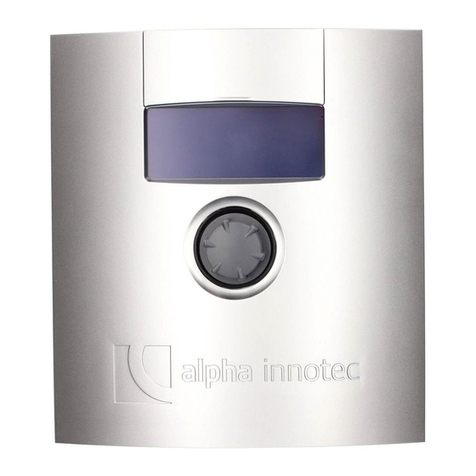
alphainnoTec
alphainnoTec Luxtronik operating instructions
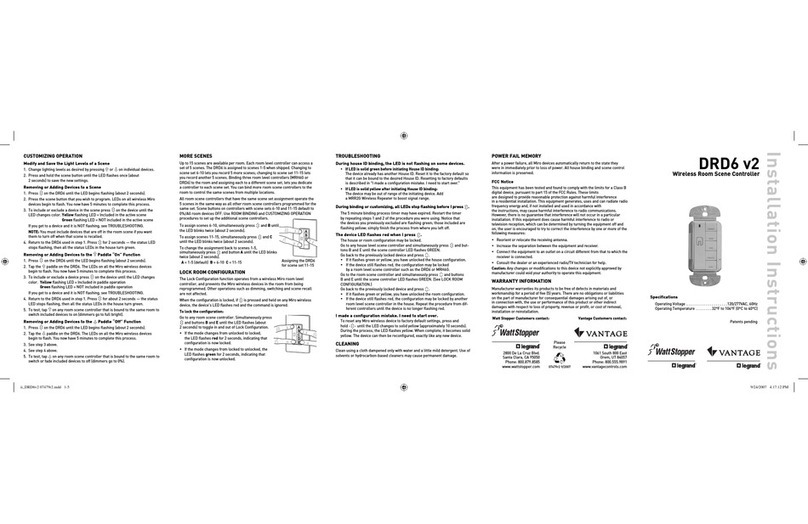
wattstopper
wattstopper DRD6 v2 installation instructions

Delta
Delta NC200 manual
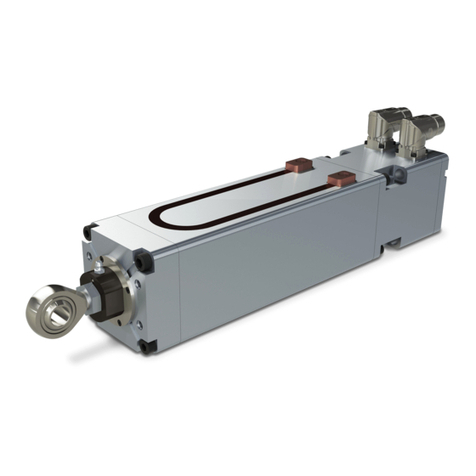
Tolomatic
Tolomatic ServoWeld CSW Installation operation & maintenance

Checkit
Checkit CG300 Series Setup guide and user manual
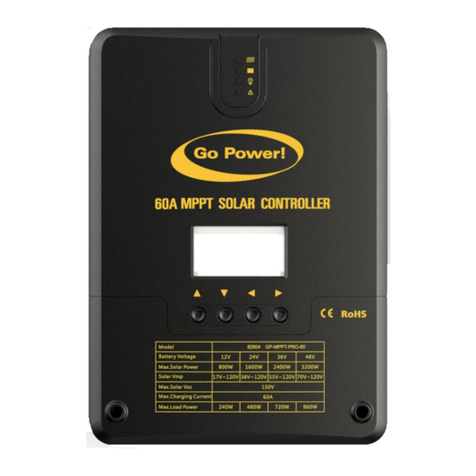
Go Power
Go Power MPPT-PRO Series user manual
